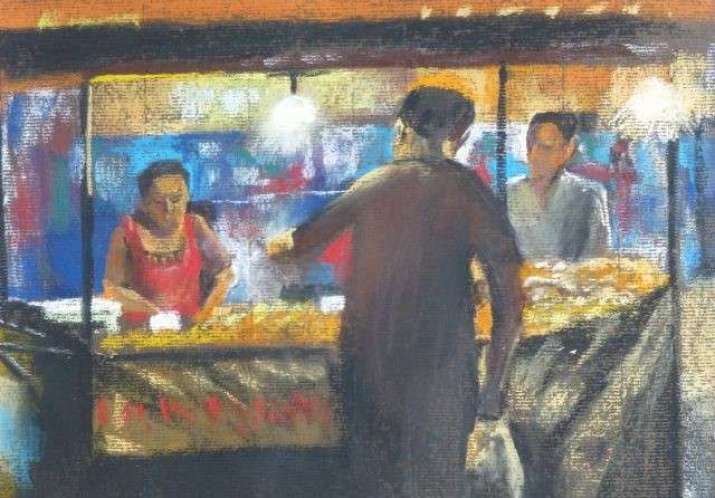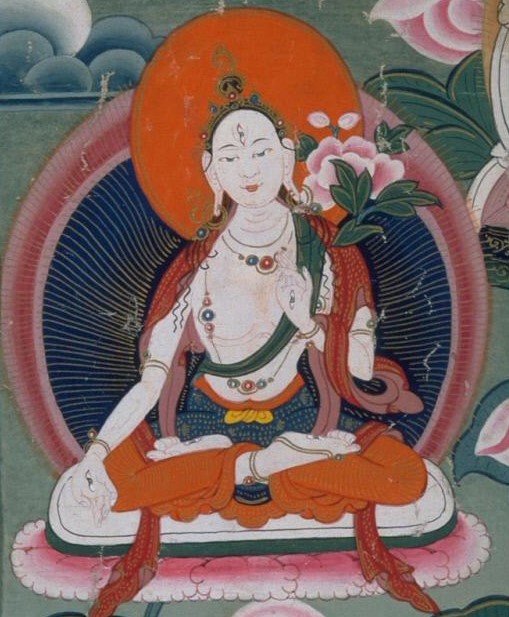FEATURES|COLUMNS|Coastline Meditations
An Encounter with Emptiness
 Night Market. From grahammcquade.wordpress.com
Night Market. From grahammcquade.wordpress.comStrolling past the various stands of a night market, a woman and her daughter stop when they see an elderly man setting figurines on a table. The woman recognizes that many of them are beautiful carvings of the Buddha, made out of a tree trunk. Taking one after the other in her hands, she is impressed by one particular piece, with its serene eyes and wise smile. She asks the man who the figurine represents, and he tells her it is Avalokiteshvara. The woman stands there for a moment, watching the soft face, its tranquility affecting her deeply. When she finally puts the figurine down, her daughter asks her, “Who is Avalokiteshvara?” For a moment, the mother is at a loss—how could she possibly explain the significance of the bodhisattva, and his discourse on emptiness, to a 10-year-old girl?
She begins with a simple question, and asks her daughter what she had been holding. The girl says, “Well it's a tree but it’s also a man.” A good place to start. They decide that, if they were to say that the figurine is just a man, it would not be correct. But if they were to say it is just a tree, it would also not be correct. After all, it is both at the same time. Together, they think of all the other things that are part of the little figurine: the Sun and the rain that nurtured the tree, and also the logger who cut the tree down; the person who carved the figurine, and the man who is selling it at the stand. Delighted, the woman exclaims that the very fact that the two of them are discussing Avalokiteshvara makes them part of the figurine as well. Through their thoughtful efforts to gain insight into emptiness, in that very moment they are bound together with the bodhisattva, the carver, the logger, the Sun, the rain. . . .
Although at first glance it seems that the figurine is just a figurine, this is not quite true—it is many other things as well. “It is the same with people,” the woman tells her daughter. “We think that we are separate from things, that we are an individual self entity. But actually, we are part of everything else. We are also made of the Sun, the rain, and other people. Without these things, we would not be here in this moment.”
“So actually we are very, very full!” the young girl laughs.
I wrote this story while I was studying Buddhism at The University of Hong Kong (HKU), trying to wrap my head around the concept of emptiness. To many, emptiness can seem contradictory to the other Buddhist teachings and may even appear depressingly nihilistic. If everything is empty, then words are empty. What is the purpose of speaking about it? Perhaps more to the point, if everything is empty, why even go on living?

Avalokiteshvara Bodhisattva. From khanacademy.org
Yet if something is empty, that does not mean it is non-existent or destroyed. Emptiness simply means devoid of a self. So if we are empty of self, we are in fact filled with many things: the Sun, the rain, and everything else! When we look deeply at the figurine, we can see that it is empty; it is not a permanent entity. It is empty because it is filled with everything else. This is why Avalokiteshvara says that all dharmas are “neither produced nor destroyed, neither defiled nor immaculate, neither increasing nor decreasing.” (Thich Nhat Hanh, 1) Even if, say, the logger is a compassionate person, and the carver is an ill-tempered one, we cannot say that one is good and the other is bad. If we look at the figurine, we see that one could not be without the other. They are both empty, because they are part of everything else.
We also cannot say that there is a point when the figuring came into existence. Was it the moment the last body part was carved into its final form? Well, before that it was already half of a figurine. And before that, it was a tree, the Sun, and many other things. It is always part of everything else, so it is always a continuation. To quote the Vietnamese Buddhist teacher and author Thich Nhat Hanh: “From nothing, we can never become something.” (Thich Nhat Hanh, 21) And from something, we cannot become nothing. Even if I become angry at Avalokiteshvara because I do not understand his teachings, and I try to destroy him, I will fail. If I throw the figurine against a wall, it will break into many pieces. But does this mean that it is no longer there? No—the form has changed, but everything is still there: the tree, the Sun, the carver. Even if I burn the wood, it continues on. It simply turns into ashes, it takes on a new form.
And it is the same for humans. According to the Buddhist teachings, we are the sum total of five aggregates: forms, feelings, perceptions, mental formations, and consciousness. And as Avalokiteshvara came to realize, all of them are empty. They are empty because they are not separate entities, they cannot exist on their own. They are all connected to each other, and to everything else. When someone dies, we feel sad because we think that that person has gone from existence to non-existence. But the person’s form has simply changed—like the figurine, it has become ashes, but it continues on. Because it has always been empty, it has always been part of everything else. Avalokiteshvara’s body changed many centuries ago, and no doubt he was said to be dead. But he only changed form. He is still here, in this very moment; he continues on in that figurine, in you and me.
References
Thich Nhat Hanh. 1988. The Heart of Understanding: Commentaries on the Prajñāpāramitā Heart Sutra. Parallax Press: Berkeley
Related features from Buddhistdoor Global
Construction of Avalokiteshvara Statue Underway in Buryatia
The Many Forms of Avalokiteshvara
Expressions of Emptiness: The Paintings and Sculptures of Yoshio Ikezaki
The Compassion of Guanyin in Carmel, New York
Nāgārjuna’s Śūnyatā Doctrine As Seen the MMK














